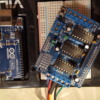Going back to the panstamp solution which spoofs a tiu -- the remote connects wirelessly to it as any other real tiu. (referring back to -- http://www.silogic.com/trains/OOK_Radio_Support.html)
Marrying the panstamp to your ardiuno could be easy -- there's a usb port on mine although it also gets power from it -- so there's some details to sort through there. (ok, to be fair nothing is easy. how 'bout easy-ish with luck...?)
Mark's RTCEngine hard codes it to TIU#4 and you can decided what to return on "read" --- well how about "Turntable001". (Maybe you'll get two one day.)
After that it's a little more code to decided which remote commands to map to what turntable function and how to tell your arduino to implement them the codes come over as text -- and those are all explained on Mark's website.
On the remote, the thumbwheel is one idea for turntable position, smph 1 for position 1 and so forth... but that's up to you to decide. Any remote codes you wish to map to the turntable commands is something you'd configure in your "tiu spoofer/ardiuno" code base ...
There's no cable except possibly between the panstamp and your arduino although maybe there are options to do away with that too. Power -- wall wart for panstamp, but battery is an option. Possibly the panstamp and arduino are powered off the same supply or same battery back...?







